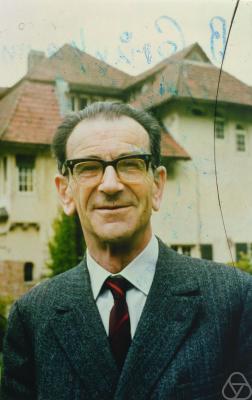Werner Fenchel facts for kids
Quick facts for kids
Moritz Werner Fenchel
|
|
|---|---|

Werner Fenchel, 1972
|
|
| Born | 3 May 1905 Berlin, Germany
|
| Died | 24 January 1988 (aged 82) Copenhagen, Denmark
|
| Citizenship | German |
| Alma mater | University of Berlin |
| Known for | Fenchel's duality theorem Fenchel's theorem Fenchel–Moreau theorem Fenchel–Nielsen coordinates Fenchel–Young inequality Alexandrov–Fenchel inequality Legendre–Fenchel transformation |
| Awards | Rockefeller Fellowship (1930) Membership in the Royal Danish Academy of Sciences and Letters (1946) |
| Scientific career | |
| Fields | Mathematics: Geometry Optimization |
| Institutions | University of Copenhagen University of Göttingen |
| Doctoral advisor | Ludwig Bieberbach |
| Doctoral students | Birgit Grodal Troels Jørgensen |
Moritz Werner Fenchel (born May 3, 1905 – died January 24, 1988) was a mathematician. He was born in Germany but lived most of his life in Denmark. Werner Fenchel is famous for his work in geometry and optimization theory.
He helped create the basic ideas of convex analysis. This field is important for solving problems in nonlinear programming. Fenchel's books and notes are still very important for mathematicians today.
Contents
Werner Fenchel's Life Story
Early Life and Schooling
Werner Fenchel was born in Berlin, Germany, on May 3, 1905. His younger brother, Heinz Fenchel, later became a film director and architect in Israel.
From 1923 to 1928, Werner Fenchel studied mathematics and physics. He attended the University of Berlin. He earned his doctorate degree in geometry. His main teacher was Ludwig Bieberbach.
Teaching in Germany
From 1928 to 1933, Fenchel worked at the University of Göttingen. He was an assistant to Professor E. Landau.
In 1930, he received a special award called the Rockefeller Fellowship. This allowed him to travel for a year. He visited Rome, Italy, and Copenhagen, Denmark. In Copenhagen, he worked with famous mathematicians like Harald Bohr. He visited Denmark again in 1932.
Moving to Denmark
Fenchel taught at Göttingen until 1933. At that time, the Nazi government in Germany started to fire Jewish people from their jobs.
Because of this, Fenchel moved to Denmark in 1933. He found a job at the University of Copenhagen. In December 1933, he married another German mathematician, Käte Sperling. She had also moved to Denmark to escape the Nazis.
When Germany took over Denmark during World War II, Fenchel and about 8,000 other Danish Jews had to flee. They found safety in Sweden. From 1943 to 1945, Fenchel taught at a Danish school in Lund, Sweden. After the war ended and Denmark was free, Fenchel went back to Copenhagen.
After the War
In 1946, Werner Fenchel was chosen to be a member of the Royal Danish Academy of Sciences and Letters. This is a very respected group of scientists and thinkers.
From 1949 to 1951, Fenchel took a break from Denmark. He taught in the United States. He worked at the University of Southern California, Stanford University, and Princeton University.
From 1952 to 1956, Fenchel was a professor. He taught mechanics at the Polytechnic in Copenhagen. Then, from 1956 to 1974, he became a mathematics professor. He taught at the University of Copenhagen.
Later Years and Legacy
Professor Fenchel passed away on January 24, 1988. His work continues to influence mathematicians around the world.
Important Math Contributions
Convex Geometry
Werner Fenchel made big contributions to convex geometry. This part of geometry studies shapes that are "convex." A shape is convex if, for any two points inside it, the straight line connecting them is also entirely inside the shape. Think of a solid ball or a cube – they are convex. A donut shape is not.
Optimization Theory
Fenchel gave lectures at Princeton University in the early 1950s. These lectures were about "Convex Sets, Cones, and Functions." His notes from these lectures were very important. They helped shape a field of math called convex analysis. This field helps solve problems where you want to find the best possible outcome. For example, finding the cheapest way to do something or the fastest route.
Hyperbolic Geometry
Fenchel also worked on hyperbolic geometry. This is a type of geometry that is different from the flat geometry we learn in school. In hyperbolic geometry, parallel lines can meet, and triangles have angles that add up to less than 180 degrees. It's a fascinating and complex area of math.
See also
 In Spanish: Werner Fenchel para niños
In Spanish: Werner Fenchel para niños
- Convex analysis
- Convex cone
- Convex function
- Convex set
- Legendre–Fenchel transformation
- Convex minimization
- Fenchel's duality theorem
- Geometry
- Convex geometry
- Brunn–Minkowski theorem
- Differential geometry
- Fenchel's theorem
- Hyperbolic geometry
- Jakob Nielsen
- Fenchel–Nielsen coordinates
- Convex geometry
- Nonlinear programming

